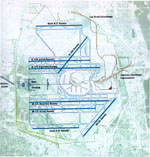MPC has both kudos and concerns for the City's new O'Hare expansion plan, which includes transportation improvements along with new runways.
Mayor Richard Daley has put forward an ambitious plan to expand and realign the runway system at O'Hare International Airport to reduce flight delays and greatly increase, over time, O'Hare's ability to handle more flights and passengers.
The mayor's plan, issued on Friday, June 29, also calls for several highway and transit improvements. These include: a western gateway to the airport through which an extended Elgin-O'Hare Expressway would lead to a new western terminal complex; a west-of-the-airport expressway bypass between the Northwest and Tri-State Tollways; and public transportation improvements such as extension of CTA rapid transit (Blue Line) service beyond O'Hare to Schaumburg.

The Metropolitan Planning Council long has been a voice for the regional approach to aviation planning. In that vein, MPC has strongly supported protecting and enhancing O'Hare as our region's most powerful economic engine . . . while at the same time encouraging balanced economic growth that would benefit the south suburbs.
The mayor's 15-year, $6 billion proposal, which promises 195,000 new jobs and $16 billion in additional economic activity, certainly would fuel the O'Hare engine. Its impact on the feasibility of a third airport, whether at Peotone or elsewhere, needs to be carefully evaluated.
As Gov. George Ryan and his state transportation team begin their review of Chicago's proposal, the major elements of which are listed below, MPC offers the following first-blush kudos and cautions.
Kudos
- Increased capacity at O'Hare. With or without a third airport, MPC believes O'Hare needs additional plane-handling capacity, both for safety's sake and to reap the economic opportunities posed by growing international air travel.
- Western access and expressway bypass. Both will help relieve the multi-expressway bottleneck at O'Hare's main, eastern gate, and in so doing speed traffic across the region for all. Western airport access, moreover, presents communities west of O'Hare with a unique economic development opportunity.
- Transit improvements. Extension of the Blue Line to Schaumburg would be the CTA's first rail expansion in decades, and a welcome one, for it would better link the city's substantial labor pool to the job-rich northwest suburbs, and vice-versa. Express service and a downtown baggage check on the Blue Line, by encouraging more O'Hare users to ride instead of drive, would benefit everyone.
Concerns
- The challenge of increased volume. The sheer size of the capacity increase proposed — 80 percent for plane operations, 100 percent for passengers — raises questions that go beyond O'Hare proper to the handling capacity of infrastructure across the northwest (city and suburban) corridor. And, of course, there is the politically-charged jet noise issue. Noise abatement efforts, from sound-proofing homes to modifying flight paths, will have to be redoubled. So should federal efforts to help design, and then require, quieter jet engines.
- Displacement. Substantial residential (up to 543 dwelling units) and commercial relocation (including the shift of a freight rail line) are called for along O'Hare's existing perimeter. Both must be handled fairly and humanely. But any industrial/commercial relocation should be done as part of a retention/redevelopment strategy that leverages the value created by a new western gateway and bypass. Also, communities whose tax bases stand to benefit in the long run may need fiscal "hold harmless" protection in the short run.
- Financing. The City's plan does not specify cost figures or sources of funding for non-airport improvements such as the expressway bypass or the CTA extension to Schaumburg. Those estimates should be made and sources identified.
- Balanced economic development. Any approval of additional capacity at O'Hare should address the economic needs of the south suburbs. Whether a point-to-point and freight airport is built at Peotone or a package of other major economic investments is made in the area, the region (including the City of Chicago) has a vested interest in providing a southern anchor to economic growth.
As city-state negotiations begin, the Metropolitan Planning Council urges all parties to think regionally, to listen carefully and respectfully to the "other side," and to seek points of agreement and compromise that will lead to a win/win outcome for the entire metropolitan area. The future belongs to regions that plan for it.